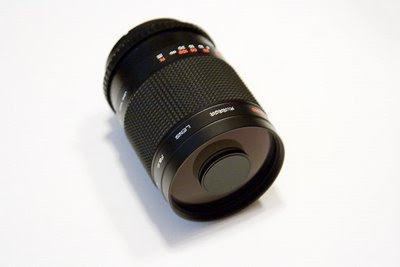I came across a store selling telescopes as camera lenses. It's reflector telescope designed to be used with cameras. Doesn't have an eyepiece, doesn't attach to a tripod. Does attach to a camera, does have a focus adjustment, marked with distances.
Looks like this:

A Canon 300mm lens is $4000 US, that's f/4, IS Image Stabilization, USM focus motor. A Canon 500mm lens is $5700, an 800mm lens is $11,000. That's more than my motorcycle!
My lens cost me $135, including shipping and border fees. At that price, you sacrifice a few incidentals, such as IS Image Stabilization. You don't get a focus motor, you have to focus manually. You don't even get an aperture, to reduce the light you have neutral density filters which cut the light be 2 and 4 f-stops. No, the filters don't go on the front, you have to take the lens off the camera and fit them on the rear.
As for the focus, you have to get it dead right. At a distance of 12 feet, you get a depth-of-field of 1/2 inch. At a distance of 6 km it took several tries to get a sharp result.

I figured at 19 km, downtown Toronto would be a simple matter of racking the focus all the way to the sideways '8'. The first shot was an embarrassing blur, you coldn't even distinguish the floor of the office towers. The second was much better, just wasn't sharp. This is the best I've managed so far.

Closer to home, 11 stories down and across the street, according to the squaw on the hippopotamus being equal to the sons of the squaws on the other two hides, call it 200 feet, 65 meters, the church side door:

I guess that's why the pamphlet that came with the lens says
Therefore, it is recommended to first practice focusing with your lens before taking any serious pictures, especially in closeup photography. It is suggested that a focus magnifier be used to help determine the depth of field sharpness under such extreme conditions.
Looks like this:

A Canon 300mm lens is $4000 US, that's f/4, IS Image Stabilization, USM focus motor. A Canon 500mm lens is $5700, an 800mm lens is $11,000. That's more than my motorcycle!
My lens cost me $135, including shipping and border fees. At that price, you sacrifice a few incidentals, such as IS Image Stabilization. You don't get a focus motor, you have to focus manually. You don't even get an aperture, to reduce the light you have neutral density filters which cut the light be 2 and 4 f-stops. No, the filters don't go on the front, you have to take the lens off the camera and fit them on the rear.
As for the focus, you have to get it dead right. At a distance of 12 feet, you get a depth-of-field of 1/2 inch. At a distance of 6 km it took several tries to get a sharp result.

I figured at 19 km, downtown Toronto would be a simple matter of racking the focus all the way to the sideways '8'. The first shot was an embarrassing blur, you coldn't even distinguish the floor of the office towers. The second was much better, just wasn't sharp. This is the best I've managed so far.

Closer to home, 11 stories down and across the street, according to the squaw on the hippopotamus being equal to the sons of the squaws on the other two hides, call it 200 feet, 65 meters, the church side door:

I guess that's why the pamphlet that came with the lens says
Therefore, it is recommended to first practice focusing with your lens before taking any serious pictures, especially in closeup photography. It is suggested that a focus magnifier be used to help determine the depth of field sharpness under such extreme conditions.
Comments